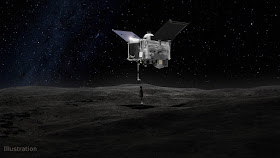ISS - Expedition 57 Mission patch.
December 8, 2018
Three days after its launch from Florida, the SpaceX Dragon cargo spacecraft was installed on the Earth-facing side of the International Space Station’s Harmony module at 10:36 a.m. EST.
SpaceX CRS-16: Dragon berthing
The 16th contracted commercial resupply mission from SpaceX delivers more than 5,600 pounds of research, crew supplies and hardware to the orbiting laboratory. Among the research it will bring to station, science investigations and technology demonstrations aboard Dragon include:
The Global Ecosystem Dynamics Investigation (GEDI) will provide high-quality laser ranging observations of the Earth’s forests and topography required to advance the understanding of important carbon and water cycling processes, biodiversity, and habitat. GEDI will be mounted on the Japanese Experiment Module’s Exposed Facility and provide the first high-resolution observations of forest vertical structure at a global scale. These observations will quantify the aboveground carbon stored in vegetation and changes that result from vegetation disturbance and recovery, the potential for forests to sequester carbon in the future, and habitat structure and its influence on habitat quality and biodiversity.
Image above: Flying over Peru, seen by EarthCam on ISS, speed: 27'592 Km/h, altitude: 409,62 Km, image captured by Roland Berga (on Earth in Switzerland) from International Space Station (ISS) using ISS-HD Live application with EarthCam's from ISS on December 8, 2018 at 14:38 UTC. Image Credits: Orbiter.ch Aerospace/Roland Berga.
A small satellite deployment mechanism, called SlingShot, will be ride up in Dragon and then be installed in a Northrop Grumman Cygnus spacecraft prior to its departure from the space station. SlingShot can accommodate as many as 18 CubeSats of any format. After the Cygnus cargo ship departs from station, the spacecraft navigates to an altitude of 280 to 310 miles (an orbit higher than that of the space station) to deploy the satellites.
Robotic Refueling Mission-3 (RRM3) will demonstrate the first transfer and long-term storage of liquid methane, a cryogenic fluid, in microgravity. The ability to replenish and store cryogenic fluids, which can function as a fuel or coolant, will help enable long duration journeys to destinations, such as the Moon and Mars.
Image above: Dec. 8, 2018: International Space Station Configuration. Six spaceships are attached at the space station including the U.S. resupply ships Northrop Grumman Cygnus and the SpaceX Dragon; and Russia’s Progress 70 and 71 resupply ships and the Soyuz MS-09 and MS-10 crew ships all from Roscosmos. Image Credit: NASA.
Growth of Large, Perfect Protein Crystals for Neutron Crystallography (Perfect Crystals) crystallizes an antioxidant protein found inside the human body to analyze its shape. This research may shed light on how the protein helps protect the human body from ionizing radiation and oxidants created as a byproduct of metabolism. For best results, analysis requires large crystals with minimal imperfections, which are more easily produced in the microgravity environment of the space station.
Dragon is scheduled to depart the station in January 2019 and return to Earth with more than 4,000 pounds of research, hardware and crew supplies.
Related article:
ISS Crew Captures Dragon
https://orbiterchspacenews.blogspot.com/2018/12/iss-crew-captures-dragon.html
Related links:
Expedition 57: https://www.nasa.gov/mission_pages/station/expeditions/expedition57/index.html
Harmony module: https://www.nasa.gov/mission_pages/station/structure/elements/harmony
Global Ecosystem Dynamics Investigation (GEDI): https://www.nasa.gov/feature/goddard/2018/gedi-to-measure-earths-forests
SlingShot: https://www.nasa.gov/mission_pages/station/research/experiments/explorer/Facility.html?#id=7847
Robotic Refueling Mission-3 (RRM3): https://orbiterchspacenews.blogspot.com/2018/11/nasa-to-launch-new-refueling-mission.html
Perfect Crystals: https://www.nasa.gov/mission_pages/station/research/experiments/explorer/Investigation.html?#id=7617
Space Station Research and Technology: https://www.nasa.gov/mission_pages/station/research/index.html
International Space Station (ISS): https://www.nasa.gov/mission_pages/station/main/index.html
Images (mentioned), Video, Text, Credits: NASA/Mark Garcia/NASA TV/SciNews/Orbiter.ch Aerospace/Roland Berga.
Greetings, Orbiter.ch














































